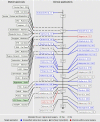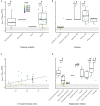Evolution and Stagnation of Image Guidance for Surgery in the Lateral Skull: A Systematic Review 1989-2020
- PMID: 33505986
- PMCID: PMC7831154
- DOI: 10.3389/fsurg.2020.604362
Evolution and Stagnation of Image Guidance for Surgery in the Lateral Skull: A Systematic Review 1989-2020
Abstract
Objective: Despite three decades of pre-clinical and clinical research into image guidance solutions as a more accurate and less invasive alternative for instrument and anatomy localization, translation into routine clinical practice for surgery in the lateral skull has not yet happened. The aim of this review is to identify challenges that need to be solved in order to provide image guidance solutions that are safe and beneficial for use during lateral skull surgery and to synthesize factors that facilitate the development of such solutions. Methods: Literature search was conducted via PubMed using terms relating to image guidance and the lateral skull. Data extraction included the following variables: image guidance error, imaging resolution, image guidance system, tracking technology, registration method, study endpoints, clinical target application, and publication year. A subsequent search of FDA 510(k) database for identified image guidance systems and extraction of the year of approval, intended use, and indications for use was performed. The study objectives and endpoints were subdivided in three time phases and summarized. Furthermore, it was analyzed which factors correlated with the image guidance error. Factor values for which an error ≤0.5 mm (μerror + 3σerror) was measured in more than one study were identified and inspected for time trends. Results: A descriptive statistics-based summary of study objectives and findings separated in three time intervals is provided. The literature provides qualitative and quantitative evidence that image guidance systems must provide an accuracy ≤0.5 mm (μerror + 3σerror) for their safe and beneficial application during surgery in the lateral skull. Spatial tracking accuracy and precision and medical image resolution both correlate with the image guidance accuracy, and all of them improved over the years. Tracking technology with accuracy ≤0.05 mm, computed tomography imaging with slice thickness ≤0.2 mm, and registration based on bone-anchored titanium fiducials are components that provide a sufficient setting for the development of sufficiently accurate image guidance. Conclusion: Image guidance systems must reliably provide an accuracy ≤0.5 mm (μerror + 3σerror) for their safe and beneficial use during surgery in the lateral skull. Advances in tracking and imaging technology contribute to the improvement of accuracy, eventually enabling the development and wide-scale adoption of image guidance solutions that can be used safely and beneficially during lateral skull surgery.
Keywords: accuracy; image-guidance; lateral skull; lateral skull base; neurotology; surgical navigation; temporal bone; temporal evolution.
Copyright © 2021 Schneider, Hermann, Mueller, Braga, Anschuetz, Caversaccio, Nolte, Weber and Klenzner.
Conflict of interest statement
SW is cofounder, shareholder, and chief executive officer of CAScination AG (Bern, Switzerland). The remaining authors declare that the research was conducted in the absence of any commercial or financial relationships that could be construed as a potential conflict of interest.
Figures






Similar articles
-
Freehand Stereotactic Image-Guidance Tailored to Neurotologic Surgery.Front Surg. 2021 Oct 7;8:742112. doi: 10.3389/fsurg.2021.742112. eCollection 2021. Front Surg. 2021. PMID: 34692764 Free PMC article.
-
Noninvasive Registration Strategies and Advanced Image Guidance Technology for Submillimeter Surgical Navigation Accuracy in the Lateral Skull Base.Otol Neurotol. 2018 Dec;39(10):1326-1335. doi: 10.1097/MAO.0000000000001993. Otol Neurotol. 2018. PMID: 30239434
-
Accuracy and feasibility of a dedicated image guidance solution for endoscopic lateral skull base surgery.Eur Arch Otorhinolaryngol. 2018 Apr;275(4):905-911. doi: 10.1007/s00405-018-4906-7. Epub 2018 Feb 13. Eur Arch Otorhinolaryngol. 2018. PMID: 29442163
-
Computer-aided surgery of the paranasal sinuses and skull base.Expert Rev Med Devices. 2005 Jul;2(4):395-408. doi: 10.1586/17434440.2.4.395. Expert Rev Med Devices. 2005. PMID: 16293079 Review.
-
The accuracy of pedicle screw placement using intraoperative image guidance systems.J Neurosurg Spine. 2014 Feb;20(2):196-203. doi: 10.3171/2013.11.SPINE13413. Epub 2013 Dec 20. J Neurosurg Spine. 2014. PMID: 24358998 Review.
Cited by
-
Drilling accuracy evaluation of a mouldable surgical targeting system for minimally invasive access to anatomic targets in the temporal bone.Eur Arch Otorhinolaryngol. 2023 Oct;280(10):4371-4379. doi: 10.1007/s00405-023-07925-x. Epub 2023 Apr 3. Eur Arch Otorhinolaryngol. 2023. PMID: 37010602 Free PMC article.
-
A Self-Configuring Deep Learning Network for Segmentation of Temporal Bone Anatomy in Cone-Beam CT Imaging.Otolaryngol Head Neck Surg. 2023 Oct;169(4):988-998. doi: 10.1002/ohn.317. Epub 2023 Mar 8. Otolaryngol Head Neck Surg. 2023. PMID: 36883992 Free PMC article.
-
Freehand Stereotactic Image-Guidance Tailored to Neurotologic Surgery.Front Surg. 2021 Oct 7;8:742112. doi: 10.3389/fsurg.2021.742112. eCollection 2021. Front Surg. 2021. PMID: 34692764 Free PMC article.
-
Interdisciplinary management of skull base surgery.J Oral Biol Craniofac Res. 2021 Oct-Dec;11(4):601-607. doi: 10.1016/j.jobcr.2021.09.002. Epub 2021 Sep 11. J Oral Biol Craniofac Res. 2021. PMID: 34567964 Free PMC article.
-
Definition of a coordinate system for multi-modal images of the temporal bone and inner ear.PLoS One. 2024 Oct 7;19(10):e0294828. doi: 10.1371/journal.pone.0294828. eCollection 2024. PLoS One. 2024. PMID: 39374254 Free PMC article.
References
-
- Krombach GA, van den Boom M, Di Martino E, Schmitz-Rode T, Westhofen M, Prescher A, et al. . Computed tomography of the inner ear: size of anatomical structures in the normal temporal bone and in the temporal bone of patients with Menière's disease. Eur Radiol. (2005) 15:1505–13. 10.1007/s00330-005-2750-9 - DOI - PubMed
-
- Kendoff ADP, Stueber V, Musahl VJAR. Perioperative management of unicompartmental knee arthroplasty using the MAKO robotic arm system (MAKOplasty). Am J Orthop. (2009) 38(2 Suppl.):16–9. - PubMed
Publication types
LinkOut - more resources
Full Text Sources
Other Literature Sources
Research Materials

